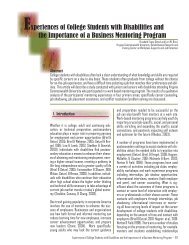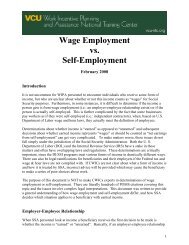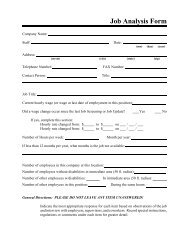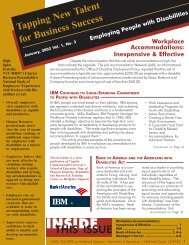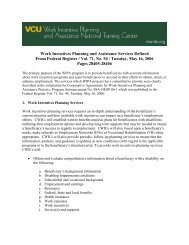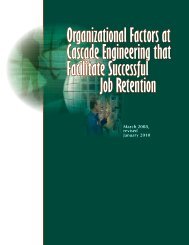Frequently Asked Questions about the Ticket to ... - Worksupport.com
Frequently Asked Questions about the Ticket to ... - Worksupport.com
Frequently Asked Questions about the Ticket to ... - Worksupport.com
You also want an ePaper? Increase the reach of your titles
YUMPU automatically turns print PDFs into web optimized ePapers that Google loves.
<strong>Frequently</strong> <strong>Asked</strong> <strong>Questions</strong> <strong>about</strong><br />
<strong>the</strong> <strong>Ticket</strong> <strong>to</strong> Work Program<br />
January 2011<br />
<strong>Questions</strong> <strong>about</strong> <strong>Ticket</strong> Eligibility and/or Assignment<br />
Question: If a person applies for EXR and is approved do <strong>the</strong>y au<strong>to</strong>matically be<strong>com</strong>e<br />
eligible for a new ticket or do <strong>the</strong>y have <strong>to</strong> wait for 24 months of payments again until<br />
<strong>the</strong>ir IRP is <strong>com</strong>plete<br />
The beneficiary’s old ticket terminates and <strong>the</strong> beneficiary be<strong>com</strong>es eligible for a<br />
new ticket immediately.<br />
Question: Can you clarify what is required for a ticket <strong>to</strong> be "in use" with a state VR<br />
agency as opposed <strong>to</strong> "assigned".<br />
Basically, <strong>the</strong> ticket must be “assigned” if <strong>the</strong> State VR agency is acting as an EN,<br />
which means <strong>the</strong> State VR agency chooses <strong>to</strong> be paid under its elected EN payment<br />
system. The State VR agency must establish an IPE for <strong>the</strong> beneficiary, and <strong>the</strong><br />
beneficiary formally agrees <strong>to</strong> assign <strong>the</strong> ticket <strong>to</strong> <strong>the</strong> VR agency as demonstrated<br />
by <strong>com</strong>pleting and signing an SSA-1365. The ticket is au<strong>to</strong>matically in-use when it<br />
is assigned, and it will remain in use throughout <strong>the</strong> ticket assignment unless <strong>the</strong><br />
beneficiary places it in Inactive Status or does not meet <strong>the</strong> timely progress<br />
requirements..<br />
If <strong>the</strong> VR agency is serving a beneficiary under <strong>the</strong> cost reimbursement option <strong>the</strong><br />
beneficiary’s ticket is NOT considered <strong>to</strong> be assigned, but it is in-use under a new<br />
status called In-Use SVR, and it continues <strong>to</strong> be in-use unless <strong>the</strong> beneficiary places<br />
it in Inactive Status or does not meet <strong>the</strong> timely progress requirements.<br />
The beneficiary will receive protection from Medical CDRs whenever <strong>the</strong> ticket is<br />
“in use,” whe<strong>the</strong>r assigned or under In-Use SVR.<br />
Question: We meet with a lot of people who may never work over SGA, but <strong>the</strong>y want <strong>to</strong><br />
assign <strong>the</strong>ir ticket and work. How does that work Are <strong>the</strong>y not a good candidate for<br />
ticket assignment<br />
Social Security is <strong>com</strong>mitted <strong>to</strong> helping SSDI and SSI disability beneficiaries return<br />
<strong>to</strong> work <strong>to</strong> <strong>the</strong> extent possible, whe<strong>the</strong>r through <strong>the</strong> <strong>Ticket</strong> program or o<strong>the</strong>r SSA<br />
work incentives. Under <strong>the</strong> new payment schedule for <strong>the</strong> Out<strong>com</strong>e-Miles<strong>to</strong>ne<br />
Payment System, <strong>the</strong>re is incentive for ENs <strong>to</strong> help beneficiaries reach TWP-level
earnings and sustain <strong>the</strong>m. While <strong>the</strong> beneficiary continues <strong>to</strong> receive cash benefit<br />
payments, <strong>the</strong> EN could earn over $9,000 based on 2011 payment rates (for more<br />
information on <strong>the</strong> 2011 out<strong>com</strong>e and out<strong>com</strong>e-miles<strong>to</strong>ne payment rates, refer <strong>to</strong><br />
http://www.yourticket<strong>to</strong>work.<strong>com</strong>/selftraining/Payments%20at%20a%20Glance%2<br />
02011.pdf ).<br />
The problem with beneficiaries who want <strong>to</strong> assign <strong>the</strong>ir ticket, but who may never<br />
work at a level which would cause loss of cash payments is that eventually <strong>the</strong>y<br />
will not make <strong>the</strong> expected progress under <strong>the</strong> program and may lose protection<br />
from a medical CDR. However, <strong>the</strong>se individuals may place <strong>the</strong> ticket in Inactive<br />
Status and au<strong>to</strong>matically forego <strong>the</strong> protection from a medical CDR indefinitely if<br />
<strong>the</strong>y don’t want SSA <strong>to</strong> conduct a progress review that <strong>the</strong>y know <strong>the</strong>y will not<br />
pass.<br />
Never discourage a beneficiary who wants <strong>to</strong> work from seeking a service provider<br />
under <strong>the</strong> ticket program <strong>to</strong> help <strong>the</strong>m work or increase earnings. Each case will be<br />
different.<br />
Question: If a person is on SSI and be<strong>com</strong>es eligible for a disability benefit, do <strong>the</strong>y get<br />
ano<strong>the</strong>r ticket<br />
No, <strong>the</strong> ticket continues in whatever status it is currently in. If it is assigned and<br />
payments have been processed on <strong>the</strong> ticket at <strong>the</strong> SSI rate, payments will continue<br />
<strong>to</strong> be processed at that rate throughout <strong>the</strong> life of <strong>the</strong> ticket. If no payments have<br />
been processed on <strong>the</strong> ticket at <strong>the</strong> SSI rate, once payments are attained <strong>the</strong>y may<br />
be processed at <strong>the</strong> rate for SSDI cases.<br />
Question: When a person puts <strong>the</strong>ir <strong>Ticket</strong> in<strong>to</strong> inactive status, is <strong>the</strong>re a time limit <strong>the</strong>y<br />
can do that for<br />
No, <strong>the</strong>re is no time limit on being in inactive status. The beneficiary would need<br />
<strong>to</strong> understand that while he/she is in inactive status, <strong>the</strong> ticket is not considered <strong>to</strong><br />
be “in use”. This means that medical CDRs may resume.<br />
Question: Is <strong>the</strong>re a potential for VR <strong>to</strong> screen through <strong>the</strong>ir beneficiaries when <strong>the</strong>y<br />
<strong>com</strong>e in and say <strong>the</strong>y don’t want someone because <strong>the</strong>y’ll never earn over SGA<br />
State VR agencies have a mandate from <strong>the</strong> federal Rehabilitation Act that requires<br />
<strong>the</strong>m <strong>to</strong> serve any eligible individuals who want <strong>to</strong> go <strong>to</strong> work and could benefit<br />
from VR services. There is no rule requiring beneficiaries <strong>to</strong> engage in SGA in<br />
order <strong>to</strong> receive services from <strong>the</strong> State VR agency. A State VR agency could not<br />
deny an o<strong>the</strong>rwise eligible individual services just for that reason.<br />
Question: Is <strong>the</strong>re a limit for how long a ticket can be used<br />
2
No, not really – as long as <strong>the</strong> ticket hasn’t been terminated or all available<br />
payments haven’t been consumed it can continue <strong>to</strong> be used. An EN could<br />
certainly decide <strong>to</strong> s<strong>to</strong>p delivering services, or <strong>the</strong> beneficiary could take <strong>the</strong> ticket<br />
out of assignment at any time.<br />
Question: If someone switches ENs, would <strong>the</strong>y pick up where <strong>the</strong>y left off on <strong>the</strong> timely<br />
progress chart<br />
Yes, all in-use months are counted, including <strong>the</strong> 90 day period when <strong>the</strong> ticket is<br />
still in-use after <strong>the</strong> ticket is unassigned or after <strong>the</strong> VR case is closed.<br />
Question: If VR serves someone, and <strong>the</strong>y go <strong>to</strong> work - in 90 days <strong>the</strong>y go <strong>to</strong> no cash<br />
payment (because <strong>the</strong>y are making <strong>to</strong>o much money), and are <strong>to</strong>ld <strong>the</strong>y can no longer<br />
assign <strong>the</strong>ir ticket. Is that still true<br />
Under <strong>the</strong> revised ticket regulations beneficiaries can assign <strong>the</strong>ir ticket during this<br />
90 day period even if not in cash payment status. To assign <strong>the</strong> ticket after this<br />
period, <strong>the</strong> beneficiary must be in current pay status.<br />
Question: Is <strong>the</strong>re a form <strong>to</strong> reassign a ticket Is <strong>the</strong>re a form <strong>to</strong> request that a ticket be<br />
placed in inactive status If you unassign your ticket and reassign with a different EN,<br />
how do you do that in writing<br />
There is no set form required <strong>to</strong> unassign or place a ticket in Inactive Status, but <strong>the</strong><br />
request must be in writing. The same rules for assigning a ticket apply <strong>to</strong><br />
reassigning a ticket. The ticket must be available for assignment and <strong>the</strong> EN and<br />
beneficiary must <strong>com</strong>plete and sign an IWP and send it <strong>to</strong> <strong>the</strong> OSM.<br />
Question: A beneficiary assigned a ticket <strong>to</strong> VR <strong>to</strong> a find job. She got a job by herself,<br />
and cancelled <strong>the</strong> ticket <strong>to</strong> VR. I’m worried <strong>about</strong> <strong>the</strong> consequences.<br />
If <strong>the</strong> VR agency can prove that <strong>the</strong> contribution of services from <strong>the</strong> VR agency<br />
during <strong>the</strong> time that <strong>the</strong> ticket was assigned <strong>to</strong> <strong>the</strong> beneficiary contributed <strong>to</strong> <strong>the</strong><br />
beneficiary’s later employment, <strong>the</strong>n <strong>the</strong> VR agency may be entitled <strong>to</strong> EN<br />
payments. There wouldn’t be any consequences for <strong>the</strong> beneficiary. She needs <strong>to</strong><br />
formally unassign her <strong>Ticket</strong> if that is her intention, and <strong>the</strong>n she’d be afforded a 90<br />
day extension period <strong>to</strong> find ano<strong>the</strong>r EN. If she doesn’t re-assign her ticket in <strong>the</strong><br />
90 day period, <strong>the</strong>n her ticket won’t be “in use” and she will be subject <strong>to</strong> medical<br />
CDRs again.<br />
Question: Can beneficiaries assign <strong>the</strong>ir ticket <strong>to</strong> an EN instead of VR if <strong>the</strong>y are<br />
attending school<br />
Certainly – as long as <strong>the</strong> beneficiary can find an EN who will agree <strong>to</strong> assignment<br />
and who is willing <strong>to</strong> provide <strong>the</strong> services and supports <strong>the</strong> beneficiary needs <strong>to</strong> be<br />
successful in school. The problem is that most ENs are not going <strong>to</strong> have <strong>the</strong><br />
3
esources equivalent <strong>to</strong> <strong>the</strong> State VR agency when it <strong>com</strong>es <strong>to</strong> paying for postsecondary<br />
education. Even though an EN may not typically fund a beneficiary’s<br />
educational pursuits, it may be able <strong>to</strong> be supportive in o<strong>the</strong>r ways, such as help <strong>the</strong><br />
beneficiary secure financial aid, arrange transportation, etc.<br />
<strong>Questions</strong> <strong>about</strong> Timely Progress<br />
Question: I have a question <strong>about</strong> <strong>the</strong> timely progress quick reference chart. Suppose a<br />
person is going <strong>to</strong> go <strong>to</strong> school, <strong>the</strong>y’ve got <strong>the</strong>ir high school diploma, but <strong>the</strong>y need <strong>to</strong><br />
work, so <strong>the</strong>y’d be using two of <strong>the</strong> programs simultaneously. So in <strong>the</strong> first 12 month<br />
period, could <strong>the</strong>y do 30% of a course load and work 3/12 months<br />
Yes, this scenario is possible. SSA recognizes that people’s lives don’t fit neatly<br />
in<strong>to</strong> 12 month increments and that attending school and working may need <strong>to</strong> be<br />
blended <strong>to</strong>ge<strong>the</strong>r at times. It is very possible <strong>to</strong> meet <strong>the</strong> timely progress<br />
requirement by achieving 50% of an educational requirement and 50% of <strong>the</strong> work<br />
requirement for that particular progress review period. As long as <strong>the</strong> <strong>to</strong>tal between<br />
<strong>the</strong> two equals or exceeds 100%, <strong>the</strong> beneficiary would be considered <strong>to</strong> be making<br />
timely progress.<br />
Question: Is it true that beneficiaries in a 4-year degree program are not required <strong>to</strong><br />
work at all during that 4-year period<br />
Yes, that is correct. Actually, it is even more lenient that that when you look at<br />
what must be achieved at <strong>the</strong> end of each 12 month progress review period. If <strong>the</strong><br />
beneficiary does not work he or she must meet <strong>the</strong> full educational requirement for<br />
each review period, i.e. 60 percent of a full course load by <strong>the</strong> end of year 1, 75<br />
percent of a full course load by <strong>the</strong> end of year 2, and a full course load in each of<br />
<strong>the</strong> next 3 years, and <strong>com</strong>pleting <strong>the</strong> program by <strong>the</strong> end of <strong>the</strong> year 6.<br />
Question: Can a person <strong>com</strong>plete a 4-year degree program and go in<strong>to</strong> year 6 without<br />
working at all<br />
Yes, technically this would be possible and <strong>the</strong> beneficiary would still be<br />
considered <strong>to</strong> have <strong>the</strong> ticket in use and making timely progress. The beneficiary<br />
must have <strong>the</strong> specified level of work, education, or a <strong>com</strong>bination of <strong>the</strong> two <strong>to</strong> be<br />
making timely progress. Whichever review period <strong>the</strong> beneficiary is at when he or<br />
she <strong>com</strong>pletes <strong>the</strong> 4 year degree, he or she must meet <strong>the</strong> work requirement for <strong>the</strong><br />
next sequential review period at <strong>the</strong> time of <strong>the</strong> next review. In essence, this means<br />
that if <strong>the</strong> beneficiary <strong>com</strong>pletes <strong>the</strong> degree program early, such as by <strong>the</strong> end of <strong>the</strong><br />
third review period, he or she must meet <strong>the</strong> work requirements of 9 out of 12<br />
months at SGA level earnings by <strong>the</strong> time of <strong>the</strong> fourth review period.<br />
However, if <strong>the</strong> beneficiary <strong>com</strong>pletes <strong>the</strong> degree requirements by <strong>the</strong> end of <strong>the</strong><br />
fourth, fifth or sixth review period, <strong>the</strong> beneficiary would need <strong>to</strong> move directly<br />
in<strong>to</strong> employment that s<strong>to</strong>ps cash payments for at least 6 out of 12 months in that<br />
4
year. If <strong>the</strong> beneficiary were receiving SSDI and had not worked at all up <strong>to</strong> this<br />
point, it would be nearly impossible <strong>to</strong> meet this requirement since <strong>the</strong> 9 month<br />
Trial Work Period would still be intact and would protect cash payments from<br />
being ceased.<br />
Question: What if a beneficiary can’t go <strong>to</strong> school or work full time<br />
The <strong>Ticket</strong> <strong>to</strong> Work rules for timely progress do not actually say that a beneficiary<br />
must go <strong>to</strong> school or work full time. Beneficiaries simply must meet <strong>the</strong> various<br />
requirements for making timely progress based on <strong>the</strong> progress review time period<br />
<strong>the</strong>y are in. For example, by <strong>the</strong> end of <strong>the</strong> first timely progress review period, a<br />
beneficiary who is working on getting <strong>the</strong>ir GED is required <strong>to</strong> have attained this<br />
goal. This does not mean that 40 hours per week have <strong>to</strong> be spent on this activity.<br />
It simply means that a certain out<strong>com</strong>e is expected at <strong>the</strong> end of <strong>the</strong> first 12 month<br />
review period. Similarly, during progress periods in which work is required, <strong>the</strong><br />
requirements relate simply <strong>to</strong> <strong>the</strong> amount of money that is earned, not <strong>the</strong> amount<br />
of time <strong>the</strong> person worked <strong>to</strong> earn that money. Some people may be able <strong>to</strong> work<br />
less than full time and still meet <strong>the</strong> SGA level earnings requirement.<br />
If <strong>the</strong> beneficiary can’t meet <strong>the</strong> level of work and/or education or training progress<br />
required for <strong>the</strong> review period, <strong>the</strong> beneficiary will lose medical CDR protection. If<br />
<strong>the</strong> beneficiary receives a medical CDR that results in benefits ceasing, he or she<br />
may apply for benefit continuation under section 301.<br />
Question: If a beneficiary is working with VR under <strong>the</strong> cost reimbursement option,<br />
when do <strong>the</strong> timely progress review periods begin<br />
The first progress review period would begin as soon as <strong>the</strong> Individual Plan for<br />
Employment (IPE) is signed and conclude after 12 months of <strong>the</strong> ticket being<br />
assigned and in-use or in use with <strong>the</strong> state VR agency under <strong>the</strong> cost<br />
reimbursement option, which is when <strong>the</strong> first progress review would be conducted.<br />
After each subsequent 12 months of ticket use, a progress review will be<br />
conducted.<br />
Question: Who is responsible for notifying <strong>the</strong> beneficiary of <strong>the</strong>ir status related <strong>to</strong><br />
timely progress reviews – <strong>the</strong> EN or MAXIMUS<br />
MAXIMUS would be responsible for this task. They will mail decision letters of<br />
adverse actions <strong>to</strong> beneficiary. They will not send a letter when <strong>the</strong> decision is<br />
favorable.<br />
Question: What if you’re working with people who received special SSI waivers <strong>to</strong><br />
prevent <strong>the</strong>m from losing <strong>the</strong>ir cash benefit – such as an individual participating in one<br />
of <strong>the</strong> Youth Transition Demonstration (YTD) projects. How would <strong>the</strong>se special rules<br />
affect <strong>the</strong> timely progress reviews<br />
5
Participation in demonstration projects such as this or <strong>the</strong> 2-for-1 demo, will not<br />
disadvantage <strong>the</strong> beneficiary, if <strong>the</strong> beneficiary’s earnings would have caused<br />
benefits <strong>to</strong> cease if he or she were not participating in <strong>the</strong> program, than that same<br />
level of earnings will be sufficient <strong>to</strong> pass <strong>the</strong> progress review for <strong>the</strong> fifth and<br />
subsequent review periods.<br />
Question: Can beneficiaries have <strong>the</strong> variance <strong>to</strong>lerance applied in only one progress<br />
review period, or more than once<br />
The variance <strong>to</strong>lerance may be applied <strong>to</strong> each progress review.<br />
Question: If a CWIC has questions <strong>about</strong> a beneficiary’s status related <strong>to</strong> timely<br />
progress who would <strong>the</strong>y contact <strong>to</strong> get clarification How do we track "timely<br />
progress" Is it through SSA or MAXIMUS<br />
The CWIC would need <strong>to</strong> obtain a signed consent <strong>to</strong> release of information from<br />
<strong>the</strong> beneficiary and <strong>the</strong>n submit <strong>the</strong> release with <strong>the</strong> question <strong>to</strong> MAXIMUS.<br />
Question: According <strong>to</strong> <strong>the</strong> timely progress chart, in <strong>the</strong> first 12 months a person<br />
<strong>com</strong>pletes a GED, <strong>the</strong>n <strong>the</strong>y pick up with <strong>the</strong> work requirement in <strong>the</strong> second 12 months.<br />
The work requirement for <strong>the</strong> second year would be 6 months with gross earnings at <strong>the</strong><br />
TWP level or above. If <strong>the</strong>y had <strong>com</strong>pleted a high school education or a degree,<br />
wouldn’t <strong>the</strong>y pick back up with <strong>the</strong> lowest work requirement<br />
No. The beneficiary is expected <strong>to</strong> make certain levels of progress <strong>com</strong>mensurate<br />
with <strong>the</strong> amount of time he or she has been in <strong>the</strong> <strong>Ticket</strong> program. The beneficiary<br />
has <strong>to</strong> attain <strong>the</strong> expected level of progress in <strong>the</strong> appropriate 12-month progress<br />
period. When <strong>the</strong> individual is in <strong>the</strong> second progress period, <strong>the</strong> first 12-month<br />
progress period options are no longer <strong>the</strong> measure of progress. The work<br />
requirement in <strong>the</strong> second 12-month progress period is TWP level earnings for at<br />
least 6 months. That is <strong>the</strong> goal <strong>to</strong> achieve in that year in order <strong>to</strong> be considered<br />
making timely progress and <strong>to</strong> continue having <strong>the</strong> ticket be “in use” for <strong>the</strong><br />
purpose of medical CDR protections.<br />
Question: The example was given of somebody studying teaching. I know that in some<br />
states you have <strong>to</strong> sit for an exam after you get <strong>the</strong> degree. Where does that exam fall in<br />
<strong>the</strong> group of timely progress<br />
The exam would not be counted <strong>to</strong>wards timely progress. The final measure that<br />
would count <strong>to</strong>wards timely progress would be whe<strong>the</strong>r <strong>the</strong> individual <strong>com</strong>pleted<br />
<strong>the</strong> degree program. The beneficiary would have six 12-month progress periods <strong>to</strong><br />
<strong>com</strong>plete <strong>the</strong> degree. In <strong>the</strong> next 12-month progress period, <strong>the</strong> requirement<br />
immediately jumps <strong>to</strong> paid employment with at least 6 of <strong>the</strong> 12 months with<br />
earnings sufficient <strong>to</strong> s<strong>to</strong>p cash payments.<br />
6
Question: If VR has a memorandum of understanding with an EN and <strong>the</strong> person is not<br />
timely progress, can <strong>the</strong> EN cancel <strong>the</strong> service<br />
These agreements are usually in place when <strong>the</strong> EN holds <strong>the</strong> ticket assignment and<br />
is referring <strong>the</strong> beneficiary <strong>to</strong> <strong>the</strong> state VR agency for services. The terms of such<br />
an agreement between <strong>the</strong> EN and a state VR agency should be upheld unless <strong>the</strong><br />
parties mutually agree <strong>to</strong> change <strong>the</strong> terms. If a dispute arises, ei<strong>the</strong>r party may seek<br />
<strong>the</strong> OSM’s help resolving it.<br />
<strong>Questions</strong> <strong>about</strong> <strong>Ticket</strong> Payments made <strong>to</strong> ENs or State VR Agencies<br />
Question: Is it possible for a beneficiary <strong>to</strong> assign <strong>the</strong>ir <strong>Ticket</strong> <strong>to</strong> an EN and at <strong>the</strong> same<br />
time have it in use with VR under <strong>the</strong> old cost reimbursement system<br />
This is not acceptable and will not happen if state VR agencies and ENs always<br />
contact <strong>the</strong> OSM concerning <strong>the</strong> availability of <strong>the</strong> ticket and subsequently submit<br />
<strong>the</strong> necessary information <strong>to</strong> assign <strong>the</strong> ticket or have it placed in In-Use SVR<br />
status. Once <strong>the</strong> OSM formally places <strong>the</strong> ticket with an organization, <strong>the</strong> system<br />
will not allow it <strong>to</strong> be simultaneously placed with a second organization.<br />
SSA also will not pay for simultaneous services provided by both organizations. If<br />
a beneficiary needs services from both organizations, SSA encourages ENs and<br />
state VR agencies <strong>to</strong> work <strong>to</strong>ge<strong>the</strong>r under partnership plus <strong>to</strong> arrange for <strong>the</strong><br />
sequence of services that best suit <strong>the</strong> beneficiary. This may require an agreement<br />
between <strong>the</strong> agencies or even <strong>the</strong> willingness of <strong>the</strong> EN <strong>to</strong> unassign <strong>the</strong> ticket <strong>to</strong><br />
allow VR <strong>to</strong> provide initial services and take <strong>the</strong> ticket assignment back for<br />
ongoing services.<br />
Question: Wouldn’t be possible <strong>to</strong> use two different ENs for two different things<br />
The ticket can only be assigned <strong>to</strong> one EN at a time. However, that EN may be a<br />
consortium of organizations that provide different types of services and work out<br />
<strong>the</strong>ir own division of EN payments made <strong>to</strong> <strong>the</strong> consortium.<br />
Question: Can <strong>the</strong> beneficiary choose <strong>to</strong> have VR use cost reimbursement instead of<br />
<strong>Ticket</strong> assignment or does VR make that decision<br />
The State VR agency makes that determination. The manner in which <strong>the</strong> VR<br />
agency is paid should not affect <strong>the</strong> quality, quantify or nature of services provided.<br />
Question: Is it true that when VR closes a case after serving a person under cost<br />
reimbursement and <strong>the</strong> ticket goes in<strong>to</strong> use with an EN later in <strong>the</strong> progress, all <strong>the</strong><br />
miles<strong>to</strong>nes would still be available since <strong>the</strong> ticket was previously in use but not<br />
assigned<br />
7
A ticket is considered <strong>to</strong> have all its value (i.e. all miles<strong>to</strong>nes available when <strong>the</strong><br />
ticket was first assigned are still available) if: a) <strong>the</strong> ticket is placed in-use under<br />
<strong>the</strong> cost reimbursement option, but not assigned <strong>to</strong> <strong>the</strong> State VR agency, and 2) <strong>the</strong><br />
individual is NOT employed at <strong>the</strong> time that <strong>the</strong> VR case is closed.<br />
Question: So if an EN were receiving payment on a beneficiary’s ticket, does that mean<br />
that <strong>the</strong> State VR agency that previously served <strong>the</strong> beneficiary cannot get paid under<br />
cost reimbursement<br />
Cost reimbursement for state VR agencies and EN ticket payments are no longer<br />
mutually exclusive. An EN can collect ticket payments on a beneficiary who<br />
assigned <strong>the</strong>ir ticket after case closure from <strong>the</strong> state VR agency. The state VR<br />
agency can also collect payment on that same beneficiary through <strong>the</strong> cost<br />
reimbursement option if <strong>the</strong> beneficiary works at SGA level for at least 9 months.<br />
Let’s look at an example of how this could work. Let’s say you’re being served by<br />
state VR and <strong>the</strong>y give you counseling and send you <strong>to</strong> a 18 month <strong>com</strong>puter<br />
program. You finish <strong>the</strong> program and get a good job, and your case is closed<br />
employed. As long as you work at SGA level for 9 continuous months, your VR<br />
agency can send a bill <strong>to</strong> SSA and be reimbursed according <strong>to</strong> SSA’s rules. After<br />
your case is closed for 6 months, you have extenuating circumstances and need<br />
additional services. (Your ticket is still assignable, i.e. still in cash payment status<br />
and meet o<strong>the</strong>r eligibility criteria). You now assign your ticket, which has never<br />
been assigned previously, <strong>to</strong> an EN. The EN provides on-<strong>the</strong>-job support services<br />
<strong>to</strong> retain <strong>the</strong> employment. That EN is also billing SSA for payments under <strong>the</strong><br />
<strong>Ticket</strong> at <strong>the</strong> same time that <strong>the</strong> VR agency is collecting reimbursement. They’re<br />
not mutually exclusive. However, <strong>the</strong> payments are for services provided during<br />
different periods of time.<br />
Question: If VR decides <strong>to</strong> go with cost reimbursement and <strong>the</strong>n <strong>the</strong>y close <strong>the</strong> file and<br />
<strong>the</strong> person reassigns it <strong>to</strong> an EN, wouldn’t <strong>the</strong> ticket start over at <strong>the</strong> beginning with<br />
Phase 1 and <strong>the</strong> first 12 month timely progress requirements<br />
Concerning <strong>the</strong> payments that would be available <strong>to</strong> <strong>the</strong> EN, this depends on <strong>the</strong><br />
beneficiary’s status at <strong>the</strong> time that VR closed <strong>the</strong> case. If <strong>the</strong> individual is<br />
employed at <strong>the</strong> time of closure, Phase 1 miles<strong>to</strong>nes are not available <strong>to</strong> an EN.<br />
Concerning timely progress, all in-use months count <strong>to</strong>ward <strong>the</strong> 12-month period<br />
even when <strong>the</strong> beneficiary moves from one service provider <strong>to</strong> ano<strong>the</strong>r. Any period<br />
when <strong>the</strong> ticket is unassigned or inactive or <strong>the</strong> beneficiary has failed a progress<br />
review, does not count.<br />
Question: I understand <strong>the</strong>re is a way VR and EN can share responsibilities within an<br />
employment plan. The EN can get miles<strong>to</strong>ne payments for a certain part of <strong>the</strong> plan and<br />
<strong>the</strong>n VR could <strong>com</strong>e in for ano<strong>the</strong>r part. Is <strong>the</strong>re a way <strong>to</strong> share that<br />
8
One such arrangement is when <strong>the</strong> VR signs a memorandum of understanding with<br />
<strong>the</strong> EN that holds <strong>the</strong> ticket assignment. The EN has <strong>to</strong> <strong>com</strong>pensate for <strong>the</strong> services<br />
<strong>the</strong>y provide according <strong>to</strong> <strong>the</strong> terms of <strong>the</strong> agreement. But <strong>the</strong> <strong>Ticket</strong> can only be<br />
assigned <strong>to</strong> one entity at a time. An EN may also unassign a ticket <strong>to</strong> allow <strong>the</strong><br />
beneficiary <strong>to</strong> work with <strong>the</strong> state VR agency <strong>to</strong> reach some of <strong>the</strong> goals of <strong>the</strong><br />
beneficiary’s employment plan with <strong>the</strong> understanding that <strong>the</strong> beneficiary will<br />
return <strong>to</strong> <strong>the</strong> EN. If <strong>the</strong> beneficiary is working when <strong>the</strong> state VR agency closes <strong>the</strong><br />
case, Phase 1 miles<strong>to</strong>ne payments will not be available <strong>to</strong> <strong>the</strong> EN that subsequently<br />
takes on <strong>the</strong> ticket assignment.<br />
Question: I understand that miles<strong>to</strong>ne payments <strong>to</strong> EN's are based on gross earnings of<br />
ticket holders but out<strong>com</strong>e payments are based on countable earnings. Is this correct<br />
Yes, this is <strong>the</strong> case although that isn’t really <strong>the</strong> way <strong>the</strong> regulations describe it.<br />
The work requirement for out<strong>com</strong>e payments is at least 6 months with earnings<br />
sufficient <strong>to</strong> cause <strong>the</strong> loss of cash benefits. When SSA suspends SSI benefits, <strong>the</strong>y<br />
look at gross countable earnings. Similarly, when SSA conducts SGA<br />
determination in order <strong>to</strong> cease disability payments, <strong>the</strong>y look at gross countable<br />
earnings.<br />
Question: What’s <strong>the</strong> likelihood that frontline VR counselors will know <strong>the</strong> difference<br />
between cost reimbursement and out<strong>com</strong>e payments Is <strong>the</strong>re training that’s<br />
happening<br />
These are program basics that VR counselor will <strong>com</strong>e <strong>to</strong> understand on an as need<br />
basis. State VR agencies rely on <strong>the</strong> VR Provider’s Handbook that SSA issues <strong>to</strong><br />
give <strong>the</strong>m in-depth information <strong>about</strong> cost reimbursement and <strong>the</strong> <strong>Ticket</strong> program.<br />
They received a revised Handbook in December 2008. Some VR agencies send<br />
<strong>the</strong>ir counselors <strong>to</strong> SSA for one-on-one training. SSA also offers annual training at<br />
<strong>the</strong> CSAVR conference. In addition, SSA is updating <strong>the</strong>ir training video for State<br />
VR agencies and will make that available.<br />
As <strong>the</strong> OSM, MAXIMUS hosts regular training via teleconference and has relevant<br />
training material on <strong>the</strong>ir website.<br />
<strong>Questions</strong> <strong>about</strong> Protection from Medical Continuing Disability Reviews<br />
(CDR)<br />
Question: I have a question <strong>about</strong> medical and work CDRs. The work CDR will<br />
continue and <strong>the</strong> beneficiary may lose <strong>the</strong>ir benefits through that<br />
Yes. The <strong>Ticket</strong> <strong>to</strong> Work is all <strong>about</strong> folks gaining financial independence through<br />
work - i.e. working <strong>the</strong>ir way off <strong>the</strong> cash benefits. The only way SSA would<br />
know how much beneficiaries are earning is <strong>to</strong> <strong>com</strong>plete a work CDR. CWICs will<br />
be able <strong>to</strong> help beneficiaries understand how work will affect <strong>the</strong>ir benefits and tell<br />
9
<strong>the</strong>m <strong>about</strong> o<strong>the</strong>r SSA work incentives that may help <strong>the</strong>m keep cash benefits<br />
longer.<br />
Question: So if someone is still not able <strong>to</strong> work <strong>the</strong>ir way beyond SGA <strong>the</strong>y won’t lose<br />
<strong>the</strong>ir benefits just because <strong>the</strong>y use <strong>the</strong> <strong>Ticket</strong><br />
No, <strong>the</strong>re’s no punishment if you don’t use it, or if you do use it and don’t achieve<br />
SGA level earnings. The ultimate goal is for someone <strong>to</strong> earn enough that his or<br />
her cash benefits s<strong>to</strong>p, but <strong>the</strong>re is no negative financial consequence <strong>to</strong> a<br />
beneficiary who does not achieve this out<strong>com</strong>e. The only negative consequence is<br />
not meeting <strong>the</strong> timely progress requirements and having medical CDR resume<br />
since <strong>the</strong> ticket would not longer be “in use”.<br />
Question: Are <strong>the</strong> CDR protections created by TWWIIA still being implemented<br />
Yes. CDR protection is only medical, though. Work reviews are always possible,<br />
whe<strong>the</strong>r a person has a ticket assigned and in use or not.<br />
Question: If <strong>the</strong>y’re behind on medical review and start working, doesn’t it kick up <strong>the</strong><br />
dust and make <strong>the</strong>m do it<br />
Report of work sometimes causes a medical CDR <strong>to</strong> be initiated. However, if <strong>the</strong><br />
beneficiary has <strong>the</strong> ticket assigned or placed in In-Use SVR status with <strong>the</strong> state<br />
VR agency, this would not be <strong>the</strong> case. The beneficiary would be protected from a<br />
medical CDR.<br />
Question: Does a person have <strong>to</strong> have <strong>the</strong>ir <strong>Ticket</strong> assigned <strong>to</strong> an EN before <strong>the</strong> TWP is<br />
<strong>com</strong>plete or just at least one month prior <strong>to</strong> earning SGA in order <strong>to</strong> receive CDR<br />
protection<br />
Nei<strong>the</strong>r. The person simply has <strong>to</strong> have <strong>the</strong>ir ticket assigned with an EN, or have a<br />
signed IPE with <strong>the</strong> State VR agency providing services under <strong>the</strong> cost<br />
reimbursement option prior <strong>to</strong> SSA initiating <strong>the</strong> medical CDR. Having said that,<br />
<strong>the</strong> beneficiary does have <strong>to</strong> be making timely progress at each 12-month progress<br />
review in order <strong>to</strong> continue <strong>to</strong> have <strong>the</strong> ticket “in use” which is what keeps <strong>the</strong><br />
medical CDRs from being initiated. The requirements for making timely progress<br />
do eventually relate <strong>to</strong> having gross earned in<strong>com</strong>e above <strong>the</strong> current TWP<br />
guideline and later having countable earnings sufficient <strong>to</strong> s<strong>to</strong>p cash benefits.<br />
Question: If a beneficiary had a ticket but has never assigned it, do <strong>the</strong>y still need <strong>to</strong><br />
have a medical CDR within <strong>the</strong> last year before applying <strong>the</strong>ir ticket with an EN I know<br />
you covered those who have a medical condition who are expected <strong>to</strong> recover and have<br />
not undergone <strong>the</strong>ir initial medical CDR, but what <strong>about</strong> those who haven’t had one in<br />
<strong>the</strong> past year I have had numerous people turned down <strong>to</strong> use <strong>the</strong>ir ticket <strong>to</strong> work<br />
because it has been more than a year since <strong>the</strong>ir last CDR.<br />
10
Under <strong>the</strong> previous ticket rules, beneficiaries classified as Medical Improvement<br />
Expected (MIE) could not get a ticket until <strong>the</strong> first medical CDR was <strong>com</strong>pleted.<br />
There was no reference in those regulations <strong>to</strong> a one year period. In some cases,<br />
<strong>the</strong> first medical CDR would be performed after one year, but some people are<br />
reviewed after 6 months, while still o<strong>the</strong>rs are not reviewed until a longer period<br />
has past.<br />
Under <strong>the</strong> new ticket rules, <strong>the</strong>re is no wait of any length for any adult disability<br />
beneficiary. Individuals who are found eligible for SSA benefits based on adult<br />
disability rules are provided a ticket immediately.<br />
Question: If a beneficiary has a <strong>Ticket</strong> considered <strong>to</strong> be "in use" but not activated, is<br />
<strong>the</strong> person still getting protection from a medical review<br />
The beneficiary will not have CDR protection when he or she has placed <strong>the</strong> ticket<br />
in inactive status, and <strong>the</strong>se inactive months do not count <strong>to</strong>ward <strong>the</strong> progress<br />
review period. The ticket is not considered in-use while it is in inactive status.<br />
However, it is still assigned <strong>to</strong> <strong>the</strong> EN or placed with <strong>the</strong> state VR agency. The<br />
beneficiary may continue <strong>to</strong> work <strong>to</strong>wards <strong>the</strong> goals in <strong>the</strong> employment plan <strong>to</strong> <strong>the</strong><br />
extent possible but does not expect <strong>to</strong> make <strong>the</strong> required progress. If <strong>the</strong><br />
beneficiary has <strong>the</strong> ticket in inactive status, receives a medical CDR that results in a<br />
medical cessation, <strong>the</strong> beneficiary may file for benefit continuation under section<br />
301.<br />
<strong>Questions</strong> <strong>about</strong> Assorted O<strong>the</strong>r Issues<br />
Question: I’ve got an EN who’s asking me <strong>to</strong> do a training for <strong>the</strong>ir staff on work<br />
incentives. Not on <strong>the</strong> <strong>Ticket</strong>, but work incentives and what <strong>the</strong>y mean for <strong>the</strong>ir<br />
beneficiaries. Can I do that<br />
You’re not prohibited from doing it, but you’re not required <strong>to</strong> do it. It is important<br />
<strong>to</strong> keep in mind that WIPA projects benefit when ENs understand how work affects<br />
<strong>the</strong> disability benefits and how <strong>to</strong> apply work incentives. As staff time permits,<br />
WIPA projects are encouraged <strong>to</strong> help ENs gain this type of knowledge.<br />
Question: Are <strong>the</strong> <strong>Ticket</strong> queries operational and are CWICs permitted <strong>to</strong> access copies<br />
of <strong>the</strong>se queries.<br />
WIPA projects and CWICs are permitted <strong>to</strong> use <strong>the</strong> BPQY for information <strong>about</strong><br />
<strong>the</strong> beneficiary, but so far, ticket status has not been included on <strong>the</strong> BPQY. SSA<br />
expects that future enhancements <strong>to</strong> <strong>the</strong> BPQY will include ticket information, but<br />
<strong>the</strong>y do not have a projected date of when this will occur.<br />
11



